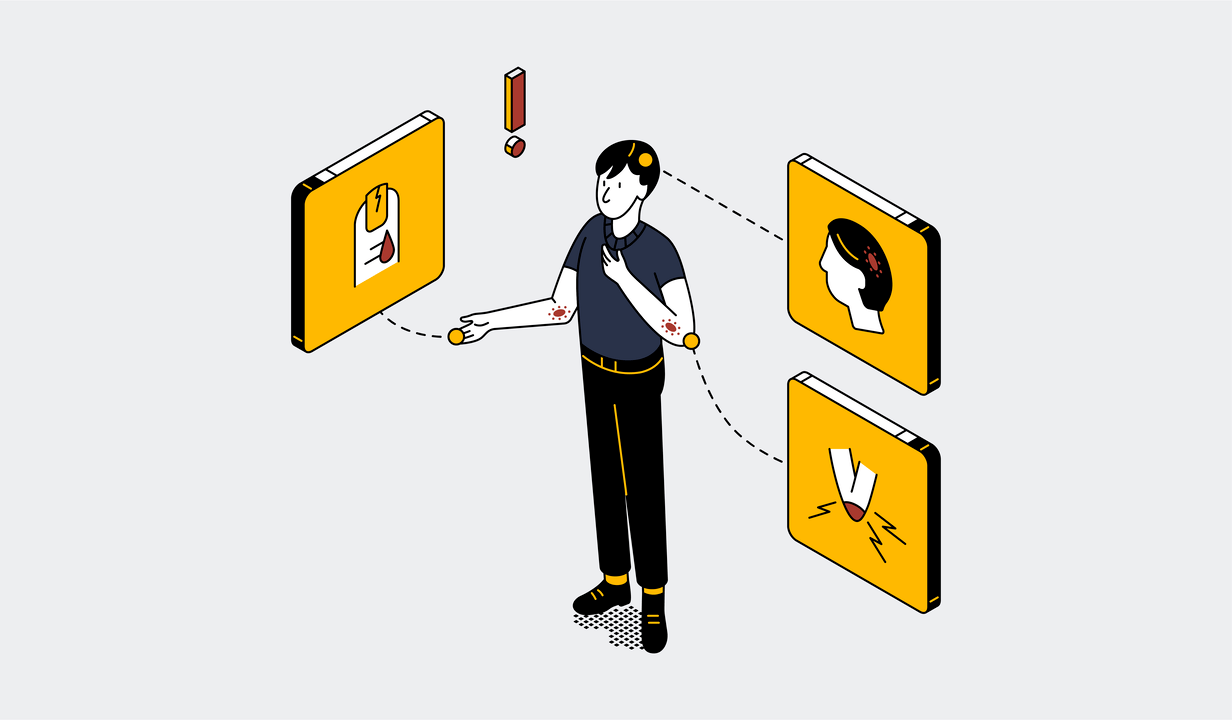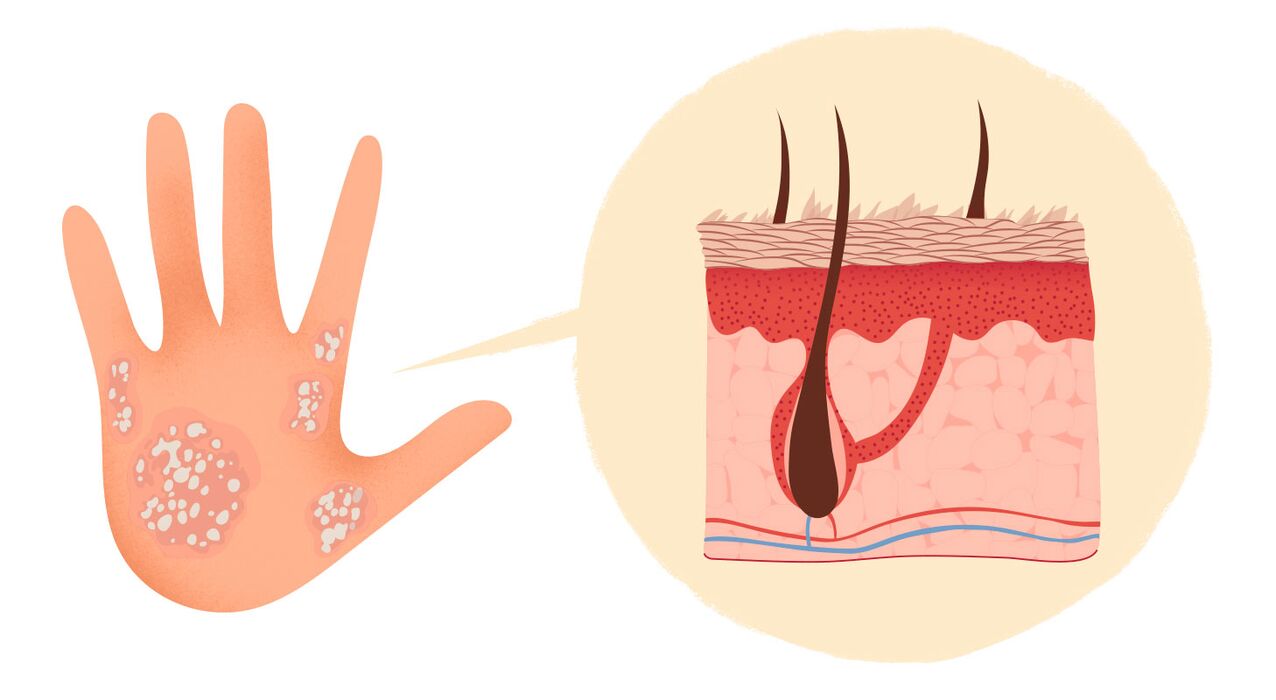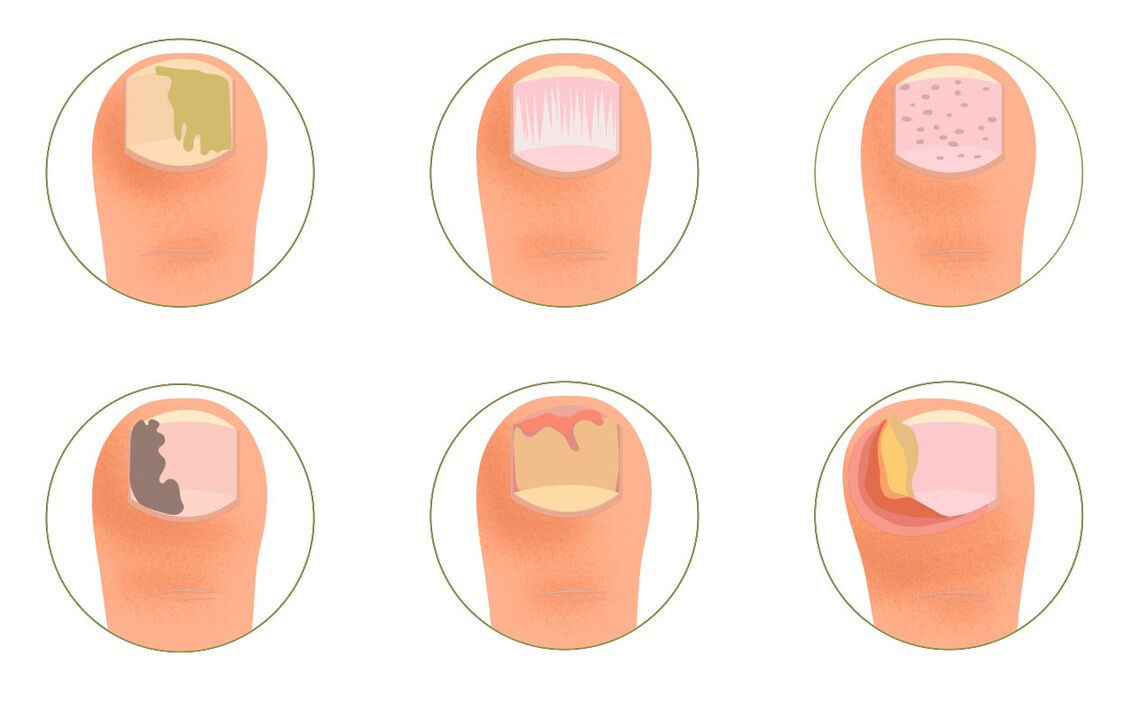
The most common symptom of psoriasis is the formation of psoriatic plaques, which form from inflamed areas of skin. However, the disease can manifest itself not only on the skin. We understand how psoriasis begins, how it progresses, and what the signs of psoriasis are.
Usually, the first symptoms of psoriasis appear at a young age, but psoriasis can pass the patient even into old age. The first symptoms of psoriasis can be subtle: it can begin with lesions on small areas of skin, often in the folds of the limbs or scalp. As a result, many patients may not notice the first symptoms. Does psoriasis skin itch? Indeed, one of the signs of psoriasis is itching. Moreover, at first, the patient can only feel itching and tightness, then red spots begin to appear on the skin.
The course of psoriasis greatly affects the quality of life of people. Many patients experience not only physical but also psychological discomfort. However, modern medicine can effectively prevent the manifestations of the disease. New drugs for psoriasis, developed in the 21st century, in particular genetically modified biological drugs (GIBPs), allow you to completely eliminate the manifestations of the disease and lead a productive life.
What is plaque psoriasis?
Psoriasis patches are the most common symptom of psoriasis. Rashes are large, inflamed red areas of skin that protrude above the surface of healthy skin and are covered with a white scab. The plaques can cause pain, itching, cracking, and bleeding.

Psoriasis. Signal
Manifestations of psoriasis on the skin and nails
Skin
- Inflammatory patches with red color.
- These patches are usually covered with white scales.
- The patches can be painful and itchy.
- Sometimes they crack and bleed.
- Scattered patches on the scalp may appear.
- The patches can grow and merge together, covering a large area of skin. In severe cases, the entire skin is a large patch. This condition is called erythroderma.
Nail
- Nails discolored or sunken, spots or stripes appear on the nail plates.
- Over time, the nail thickens and changes color to gray, yellow, or brown. It may collapse and bleed.
- Nails can peel and flake off. The skin under such torn nail thickens due to the formation of psoriatic plaques here.

The most common symptoms of psoriasis
Itching and bleeding with psoriasis
Itching and burning of the skin are common psoriasis symptoms that are concerned by 90% of patients. Itching caused by psoriasis is different from itching caused by other skin diseases. The itching in psoriasis can be very intense, and even occur on areas of skin that do not have plaques. Scratching the skin from itching in psoriasis can lead to the appearance of new rashes due to mechanical trauma to the skin.
Appearance of cracks in the skin and bleeding when having psoriasis
Psoriasis patches can appear anywhere on the skin. Sometimes they crack because the skin becomes very dry on the plaques. As the plaque increases, the cracks widen. As they get older, they can go deeper into the dermis, the layer of skin that contains capillaries. Then the capillaries are damaged and ruptured, and the plaques begin to bleed.
The first symptoms of psoriasis can occur anywhere, but more often the skin begins to crack and bleed. Location of the manifestations:
- elbow;
- knee;
- drawing pen;
- palms and soles of feet.
Pustules with psoriasis
Pustules with white or yellow fluid inside, appearing in patches of psoriasis are the main symptoms of pustular psoriasis. This is a rare form of psoriasis and only 2% of patients develop pustules. Pustular psoriasis is a very dangerous condition. It can cause serious complications, therefore urgent complex treatment and referral to a specialist is required.
How are pustules formed? How does pustular psoriasis begin?
- First, with pustular psoriasis, patches form, formed by dry, red, painful skin.
- Then the pus-filled pustules form patches.
- The pustules quickly coalesce to form large vesicles.
- They then dry out and slough off, leaving dry skin underneath, on which they can soon reappear.
Tear Drops For Psoriasis
Small, pinkish-red or pinkish scabs - patches of skin that look like drops of water - are a distinguishing symptom from teardrop psoriasis. A patient may experience several to hundreds of teardrop-shaped particles. Nodules are anywhere on the skin, but most commonly occur on:
- shoulders;
- Stomach;
- come back;
- hands;
- foot;
- head skin;
- ears;
- face to face.
Symptoms of guttate psoriasis develop fairly quickly, within days. Sometimes teardrop-shaped patches cause itching in psoriasis. Usually such elements are small in size, the width of which is not more than 10 mm.
Usually, teardrop psoriasis flares up after an infection, mainly of the respiratory tract.
Pain from psoriasis
The burning pain of a rash occurs when the skin is damaged and cracked due to excessive thickening of the skin due to inflammation and the overgrowth of keratinocytes. As a result, nerve endings in the dermis are stimulated and send pain signals to the brain.
But pain isn't just caused by mechanical damage to the skin: the inflammation that occurs in the body with psoriasis affects how the brain perceives pain. Furthermore, each person has a unique threshold of sensitivity to pain, so pain in patients with the same picture of the disease may cause a different response.
42% of patients complain of pain in the projection area of psoriasis lesions. To a greater extent, this symptom is common among:
- women;
- older people;
- patients with severe psoriasis;
- the patient has had psoriasis for a long time;
- Patients with concomitant psoriasis.
Peeling (dandruff) with psoriasis
Scalp psoriasis patches are hidden and may not be visible. However, as with other areas of the body, the patches of psoriasis flake off, forming dandruff-like flakes. Don't confuse psoriasis with dandruff, because dandruff is caused by a fungal infection and psoriasis is caused by inflammation. Therefore, these symptoms need to be treated in different ways.
Like other symptoms of psoriasis, psoriasis appears during exacerbations and disappears during remission. Exacerbations of scalp psoriasis occur for several reasons:
- cold weather;
- dry air;
- stress.
Comments on what to do when psoriasis and inflammation occur
Nail changes during psoriasis
- Half of patients with psoriasis develop nail psoriasis, and in patients with psoriatic arthritis, this symptom occurs in 80% of cases. As a rule, the defeat of the nail plate precedes the development of psoriatic arthritis.
- Often, nail psoriasis is accompanied by other types of skin psoriasis. Only 5-10% of patients with nail psoriasis have no skin lesions.
- Nail psoriasis occurs in different patients, regardless of age, sex or duration of the disease.
- The changes can affect all or part of the nail plate. They appear both on one and several nail plates, and more often on the hands.
- Psoriasis of the nails is often accompanied by common (vulgar) psoriasis and psoriatic arthritis.
- Psoriasis affects the condition of the nails in different ways. They may grow faster or thicker. Nail patches often turn white, yellow, or brown.
- Thimble-shaped indentations and stripes appear on the nail.
- With the progression of the psoriatic process, the nail begins to deteriorate and is eventually rejected, losing connection with the nail bed.
- Nail damage causes discomfort and pain that significantly reduces quality of life.

























